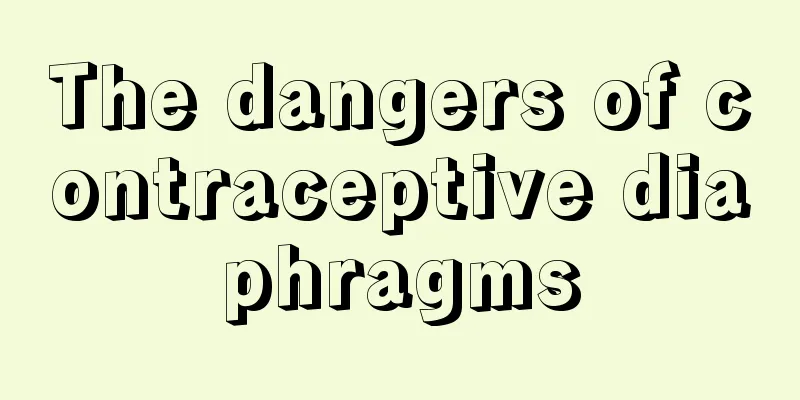How many days after the menstrual period is the safe period

|
When it comes to pregnancy contraception measures, many people like to talk about "safe period" and "safe period". So what is the "safe period" and what are the safe periods? When is the safe period? Is the safe period definitely safe? The safe period is generally calculated from the first day of menstruation. The 7 days before menstruation and the 8 days after menstruation are relatively safe, which is what people often call "7 before and 8 after". However, the safe period is not necessarily safe, it just means the chance of pregnancy is relatively low, and this safe period is more accurate for people with regular menstruation. If the menstruation is irregular, it is generally prohibited. Some people may also experience mild tingling, breast swelling, or wire pulling during ovulation (the elasticity of cervical mucus reaches its maximum, and it can expand by about 10 cm if pulled hard), but most people do not have obvious changes. If you do not accurately measure your body temperature during ovulation, you will not be able to grasp the opportunity. Therefore, if you don't want to have a baby for the time being, you must take safety precautions during the safe period. Many people take emergency contraceptive pills just for convenience, but statistics show that only 80% of contraceptive pills can actually prevent pregnancy, which means there is still a 20% chance of pregnancy. It is not very safe and can easily lead to irregular menstruation. What is the safe period? When is it easiest to get pregnant? The safe period refers to the period when the chance of pregnancy is very high. Specifically, it is about 2-3 days before ovulation and a few days after ovulation. This is because male sperm can survive in the female body for 3-5 days, while the egg cell can only survive about 1 day after ovulation. If the two can meet in this period, pregnancy is possible. As I just said, sperm can survive in the female body for 3-5 days, while egg cells can only survive for about 1 day. To be more precise, the safe period is 5 days before ovulation, 1 day after ovulation, plus 1 day during ovulation, which is a total of 7 days. If the menstrual cycle is 28 days and ovulation occurs 14 days before the next menstrual period, then the 9th to 15th day after the menstrual period is over is the safe period. However, since the ovulation period varies from person to person, the most traditional calculation is based on 5 days before ovulation and 4 days after ovulation. Maybe everyone is a little confused when I say that, so I will give you an example. For example, if your period starts on the 1st of every month, ends on the 7th, then you enter the safe period on the 16th, and the ovulation period on the 17th. From the 16th to the 21st, it is a period when you are prone to pregnancy. It should be said that the highest pregnancy success rate is a few days before ovulation. Many people think that the pregnancy rate is highest during the wedding night of ovulation. In fact, it is lower than that in the 4 days before ovulation, and the pregnancy rate after ovulation is lower than that in the 4 days before ovulation. This is because it takes 3-5 days for the male sperm to enter the uterus and fuse with the egg cell. On the wedding night of ovulation, the egg cell discharged is likely to die before the arrival of male sperm. To sum up, it is not enough to predict ovulation after the menstrual period is over to prevent pregnancy or increase the success rate of pregnancy, because the menstrual period changes with the environment, work pressure or women's mood, resulting in delayed or early menstruation, and the ovulation system may be disrupted. Therefore, those who want to take contraceptive measures are better to take safety precautions, and those who want a baby should accurately measure the body temperature during ovulation (generally the body temperature will suddenly drop on the day of ovulation, and if the high temperature period lasts for more than 17 days, it is possible that pregnancy has occurred), use LH pregnancy test paper to accurately measure, or use B-ultrasound to accurately measure the size of the egg in the uterus and ovaries to detect the ovulation period. |
<<: Why does menstruation cause stomach pain?
>>: Why do some girls not have dysmenorrhea?
Recommend
Sometimes when you are bitten by a dog, is it not enough to just get a rabies vaccine? !
A few days ago, the child of Yaowa's friend s...
Side effects of private parts whitening surgery
Many women are very concerned about the appearanc...
Frequent urination and pain may indicate infection, which is related to the low urine output.
A young male patient went to the hospital for tre...
How should women take care of themselves after hysterectomy?
The number of patients with gynecological disease...
Children’s urine routine test: Does positive urine sugar mean diabetes?
Author: Song Wenqi, National Children's Medic...
How safe is medical abortion?
Medical abortion, also known as drug abortion, us...
It can greatly relieve stress and make you feel happy. There are so many benefits to visiting the park!
□ Li Zhengrong Recently, a hot word "20-minu...
What to do if your face is itchy during pregnancy
The body undergoes significant changes after preg...
Beware of your ready-to-eat foods: They may be resistant to antibiotics
Many people are busy at work and have to rush thr...
Will a bad liver make you ugly? How can I protect my "little liver"?
A bad liver will make you ugly, it's no joke ...
What are the taboos of taking Chinese medicine during breastfeeding?
Traditional Chinese medicine is a kind of medicin...
The cause of excess testosterone in women
I believe that female friends definitely don’t wa...
What should pregnant women with anemia and high blood sugar pay attention to?
Some female friends pay special attention to thei...
The dangers of masturbation addiction in girls
Now the society has made great progress, of cours...
How does China's non-invasive brain-computer interface technology achieve "mind typing"?
In May 2023, there was a piece of news that many ...

![[Medical Q&A] Is PCOS dangerous? Is it a tumor or ovarian cancer?](/upload/images/67f11716b74bb.webp)







